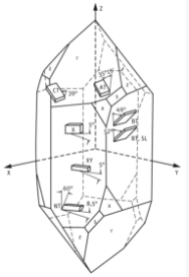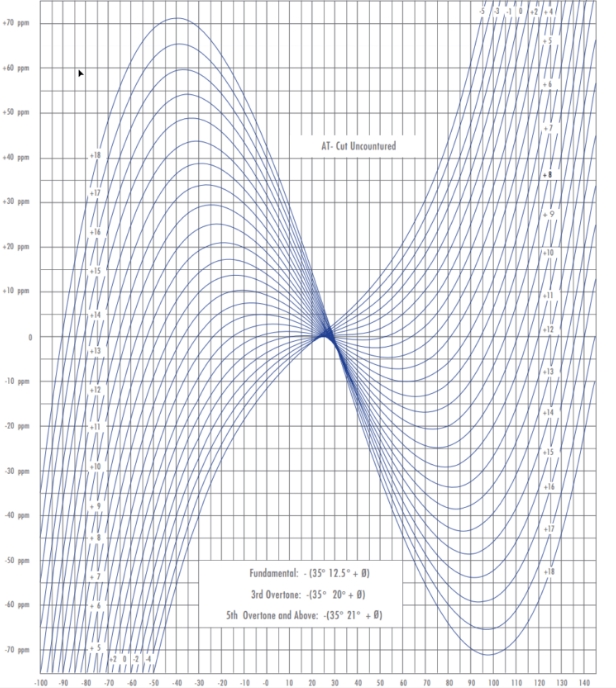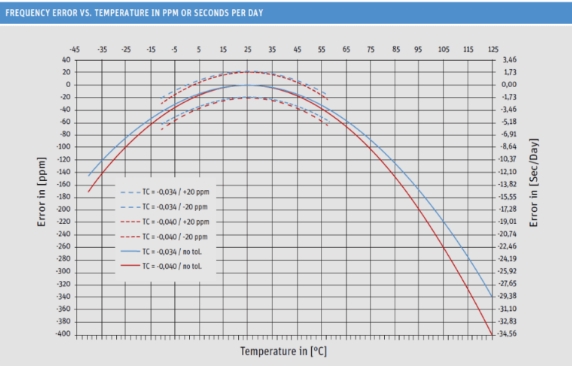SMD晶振C5S-16.000-10-1530-X-R温度多少最合理?6G常用晶振
SMD晶振C5S-16.000-10-1530-X-R温度多少最合理?6G常用晶振。伴随着行业的发展,安基作为行业的领先者,源源不断向市场提供极具有价值的产品,并通过向市场提供优质的产品,赢得无数用户的支持与认可,为了能够保持持续业绩增长,安基公司利用自身的核心技术,为行业创造更大的价值,并针对目前的进行深入的观察与调研,针对性开发适合广大应用程序的产品,经过长期的钻研,发布新型SMD晶振编码C5S-16.000-10-1530-X-R,型号C5S,频率为16MHZ,微处理器晶体单元,汽车级5.0x3.2毫米表面安装- 4 Pad,产品具有低功耗低损耗高品质的特点,很适合用于智能家居,航空电子,汽车音响等领域。
Nowadays, Christmas without quartz crystals is unimaginable! Why? Even the modern time switches for outdoor lighting need a quartz to have an accurate time base. Also, a lot of our gifts are based on state-of-the-art electronics. Cell phones, smartwatches, PCs – they all need highly accurate frequency giving components to communicate with each other. Without this communication, their usefulness is severely limited, or even non-existent. The devices usually receive the necessary driving rhythm from a quartz, the modern “heart” of such a device.
“Oscillating crystals change their behavior and electrical properties as a function of temperature,” explains , engineer for frequency giving components at Quartz. Hence, temperature changes lead to frequency deviations. This deviation is measured in “parts per million (ppm)” – which means:
1ppm = 1 part per million = 0.000001 = 0.0001%.
|
|
Aker Technology | 石英晶体 | Crystal 0.032768MHz ±20ppm (Tol) 12.5pF 50000Ohm 4-Pin SMD T/R |
|
|
Aker Technology | 石英晶体 | Crystal 0.032768MHz ±20ppm (Tol) 12.5pF FUND 65000Ohm 2-Pin SMD T/R |
|
|
Aker Technology | 石英晶体 | Crystal 26MHz ±15ppm (Tol) ±30ppm (Stability) 10pF 4-Pin CSMD T/R |
|
|
Aker Technology | 石英晶体 | Crystal 25MHz ±50ppm (Tol) ±100ppm (Stability) 8pF FUND 100Ohm Automotive 4-Pin SMD T/R |
|
|
Aker Technology | 石英晶体 | Crystal 25MHz ±15ppm (Tol) ±30ppm (Stability) 10pF FUND 100Ohm 4-Pin SMD T/R |
|
|
Aker Technology | 石英晶体 | Crystal 20MHz ±15ppm (Tol) ±30ppm (Stability) 12pF FUND 100Ohm 4-Pin SMD T/R |
|
|
Aker Technology | 石英晶体 | Crystal 27MHz ±15ppm (Tol) ±30ppm (Stability) 10pF FUND 120Ohm 4-Pin SMD T/R |
|
|
Aker Technology | 石英晶体 | Crystal 24MHz ±15ppm (Tol) ±30ppm (Stability) 12pF FUND 100Ohm 4-Pin SMD T/R |
|
|
Aker Technology | 石英晶体 | Crystal 16MHz ±15ppm (Tol) ±30ppm (Stability) 10pF FUND 50Ohm 4-Pin SMD T/R |
|
|
Aker Technology | 石英晶体 | Crystal 16MHz ±15ppm (Tol) ±30ppm (Stability) 10pF FUND 100Ohm 4-Pin SMD T/R |
|
|
Aker Technology | 石英晶体 | Crystal 37.4MHz ±15ppm (Tol) ±30ppm (Stability) 12pF FUND 80Ohm 4-Pin SMD T/R |
|
|
Aker Technology | 无源晶振 | Crystal 32MHz ±15ppm (Tol) ±30ppm (Stability) 12pF FUND 80Ohm 4-Pin SMD T/R |
|
|
Aker Technology | 石英晶体 | Crystal 26MHz ±15ppm (Tol) ±30ppm (Stability) 10pF FUND 100Ohm 4-Pin SMD T/R |
|
|
Aker Technology | 石英晶体 | Crystal 26MHz ±15ppm (Tol) ±30ppm (Stability) 10pF FUND 100Ohm 4-Pin SMD T/R |
|
|
Aker Technology | 石英晶体 | Crystal 50MHz ±15ppm (Tol) ±30ppm (Stability) 12pF FUND 60Ohm Automotive 4-Pin SMD T/R |
|
|
Aker Technology | 石英晶体 | Crystal 27MHz ±15ppm (Tol) ±30ppm (Stability) 12pF FUND 100Ohm 4-Pin SMD T/R |
|
|
Aker Technology | 石英晶体 | Crystal 54MHz ±15ppm (Tol) ±30ppm (Stability) 10pF FUND 60Ohm Automotive 4-Pin SMD T/R |
|
|
Aker Technology | 石英晶体 | Crystal 40MHz ±15ppm (Tol) ±30ppm (Stability) 10pF FUND 50Ohm 4-Pin SMD T/R |
|
|
Aker Technology | 石英晶体 | Crystal 20.48MHz ±15ppm (Tol) ±30ppm (Stability) 10pF FUND 100Ohm 4-Pin SMD T/R |
|
|
Aker Technology | 石英晶体 | Crystal 16MHz ±15ppm (Tol) ±30ppm (Stability) 10pF FUND 100Ohm 4-Pin SMD T/R |
|
|
Aker Technology | 石英晶体 | Crystal 40MHz ±15ppm (Tol) ±30ppm (Stability) 10pF FUND 60Ohm 4-Pin SMD T/R |
|
|
Aker Technology | 石英晶体 | Crystal 48MHz ±15ppm (Tol) ±30ppm (Stability) 10pF FUND 60Ohm 4-Pin SMD T/R |
|
|
Aker Technology | 石英晶体 | Crystal 30.72MHz ±15ppm (Tol) ±30ppm (Stability) 10pF FUND 80Ohm Automotive 4-Pin SMD T/R |
|
|
Aker Technology | 石英晶体 | Crystal 27MHz ±15ppm (Tol) ±30ppm (Stability) 10pF FUND 100Ohm 4-Pin SMD T/R |
|
|
Aker Technology | 石英晶体 | Crystal 27.12MHz ±15ppm (Tol) ±30ppm (Stability) 10pF FUND 100Ohm 4-Pin SMD T/R |
|
|
Aker Technology | 石英晶体 | Crystal 30MHz ±15ppm (Tol) ±30ppm (Stability) 12pF FUND 80Ohm 4-Pin SMD T/R |
|
|
Aker Technology | 石英晶体 | Crystal 24.576MHz ±15ppm (Tol) ±30ppm (Stability) 10pF FUND 100Ohm Automotive 4-Pin SMD T/R |
|
|
Aker Technology | 石英晶体 | Crystal 6MHz ±15ppm (Tol) ±30ppm (Stability) 10pF FUND 110Ohm 4-Pin SMD T/R |
|
|
Aker Technology | 石英晶体 | Crystal 25MHz ±15ppm (Tol) ±30ppm (Stability) 10pF FUND 100Ohm 4-Pin SMD T/R |
|
|
Aker Technology | 石英晶体 | Crystal 36MHz ±15ppm (Tol) ±30ppm (Stability) 12pF FUND 80Ohm Automotive 4-Pin SMD T/R |
|
|
Aker Technology | 石英晶体 |
Crystal 8MHz ±15ppm (Tol) ±30ppm (Stability) 10pF FUND 150Ohm Automotive 4-Pin SMD T/R |
The temperature sensitivity of AT-cut crystals
Oscillating crystals in the MHz range are also called AT-cut crystals. They contain thin quartz wafers, the so-called quartz blanks. AT-cut quartz blanks are cut from the quartz block at the AT angle at 35°. The thickness of the blanks is essentially responsible for the fundamental frequency at room temperature. However, the exact angle at which this quartz blank was cut from the quartz block is responsible for the deviation of the frequency at other temperatures. If the ideal angle of 35°15′ is hit very precisely in the cutting process, the quartz becomes less sensitive to temperature.
On the left you can see different cutting angle options.
The temperature sensitivity runs as a function of a cubic parabola. During cutting, even minimal inaccuracies in the range of single angular seconds lead to a rotation of the curve around the inflection point. This worsens the temperature sensitivity in the desired temperature range for the subsequent application. During the manufacturing process of the blanks, the perfect cutting angle can only be achieved to a limited extent due to the possible maximum manufacturing accuracy. Therefore, the manufactured blanks must be sorted according to their deviation and used for the appropriate crystals according to their accuracy.SMD晶振C5S-16.000-10-1530-X-R温度多少最合理?6G常用晶振
Fig. 1: The curves of the frequency deviation versus temperature resulting from the deviation of the intersection angle.Temperature dependence of tuning fork crystals
For tuning fork quartz crystals (also called clock quartz crystals) the function of an inverted parabola describes the temperature dependence of the frequency. The vertex of the parabola at a temperature-dependent frequency deviation of 0 ppm is in this case at 25 °C. At lower and at higher temperatures, for example to the left and to the right of this point, the frequency falls increasingly – and according to a quadratic curve. If the quartz in the circuit is correctly adjusted, there will be a temperature-related lag, for example with a RealTimeClock. The developer of an application must definitely take this into account.
Fig. 2: A parabolic curve describes the temperature dependence of the frequency of tuning fork crystals.What does this mean for the application?
Both temperature curves show that extreme temperatures have an influence on the frequency of quartz crystals. For the majority of applications, a slight temperature-related change in frequency, for example of +/-15 ppm in the range from -40 °C to +85 °C, is not a problem. However, if a more accurate frequency is required, it is recommended to use a temperature compensated crystal oscillator, called TCXO. This provides a very high frequency accuracy in the range of a few ppm even over wide temperature ranges.
We will be happy to advise you on the selection of the right clock generator for your application.
如今,没有石英晶振的圣诞节是不可想象的!为什么?即使是现代的户外照明时间开关也需要石英来获得准确的时间基准。此外,我们的许多礼物都是基于最先进的电子产品。手机、智能手表、个人电脑——它们都需要高精度的频率给定元件来相互通信。如果没有这种交流,它们的用处就会受到严重限制,甚至不存在。这些设备通常从石英接收必要的驱动节奏,石英是这种设备的现代“心脏”。
频率给定组件工程师解释说:“振荡晶体会随着温度的变化而改变其行为和电气特性。因此,温度变化会导致频率偏差。这种偏差以“百万分之几(ppm)”来衡量,这意味着:
1ppm =百万分之一= 0.000001 = 0.0001%。
AT切割晶体的温度敏感性

MHz范围内的振荡晶体也称为AT切割晶体。它们包含薄石英晶片,即所谓的石英坯。at切割石英坯是以35°的AT角从石英块上切割下来的。坯件的厚度基本上决定了室温下的基频。然而,石英坯从石英块上切割下来的准确角度是造成其他温度下频率偏差的原因。如果在切割过程中非常精确地达到35° 15′的理想角度,石英对温度的敏感度就会降低。
在左侧,您可以看到不同的切割角度选项。
温度灵敏度是三次抛物线的函数。在切割过程中,即使是单角秒范围内的最小误差也会导致曲线围绕拐点旋转。这恶化了后续应用所需温度范围内的温度灵敏度。在坯件的制造过程中,由于可能的最大制造精度,完美的切割角度只能在有限的范围内实现。因此,制造的毛坯必须根据它们的偏差进行分类,并根据它们的精度用于合适的晶振晶体。
图1:由交角偏差产生的频率偏差对温度的曲线。
音叉晶体的温度依赖性
对于音叉石英SMD晶振(也称为时钟石英SMD晶体),倒抛物线的函数描述了频率的温度依赖性。在这种情况下,温度相关频率偏差为0 ppm时的抛物线顶点在25°c,在较低和较高的温度下,例如在该点的左侧和右侧,频率逐渐下降,并且符合二次曲线。如果电路中的石英调整正确,将会有一个与温度相关的滞后,例如实时时钟。应用程序的开发人员一定要考虑到这一点。
图2:抛物线描述了音叉晶体频率的温度依赖性。
这对应用程序意味着什么?
两条温度曲线都表明极端温度对石英晶体的频率有影响。对于大多数应用而言,与温度相关的微小频率变化(例如-40°C至+85°C范围内的+/-15 ppm)不成问题。然而,如果需要更精确的频率,建议使用温度补偿晶体振荡器,称为TCXO。这提供了非常高的频率精度,即使在很宽的温度范围内也能达到几个ppm。
相关台湾晶振行业资讯
- 从可穿戴到工业应用: 1.2V TCXO的全方位革新
- 安基科技推出全新超小型石英晶体系列,适用于空间有限的应用
- DIODES Crystal vibration company profile
- NKG晶振公司严格遵守ROHS以及其他环保条例,01-CR3-12-32K768-06-20N-CMR贴片晶振
- 拥有最全面产品类型的NKG晶振,CT25M22.1184F10V1T-100晶振
- 安基SMD振荡器编码曝光
- 品质如一的主流AKER石英晶体系列
- 领先同行Siward active crystal oscillator应用场景
- 加高全面性的低成本SMD晶体遥遥领先
- SMD晶振C5S-16.000-10-1530-X-R温度多少最合理?6G常用晶振










